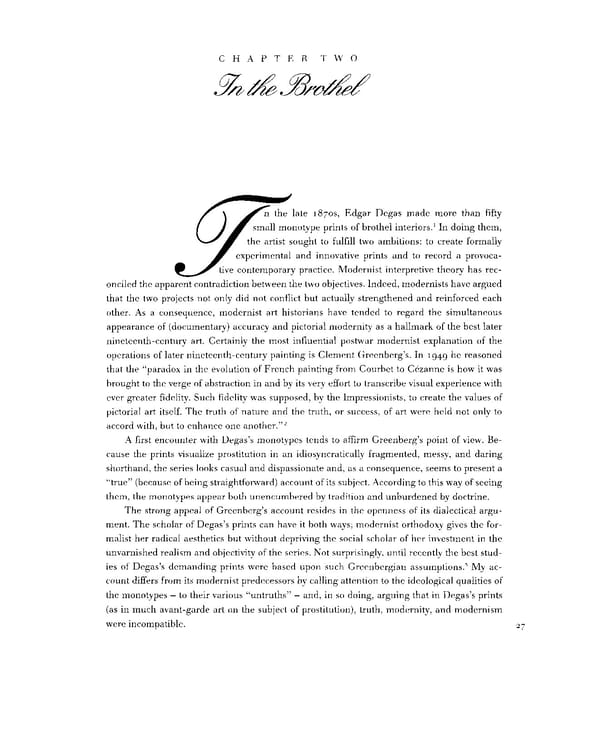CHAPTER TWO In the Brothel n the late 18705, Edgar Degas made more than fifty 1 small monotype prints of brothel interiors. In doing them, the artist sought to fulfill two ambitions: to create formally experimental and innovative prints and to record a provoca- T tive contemporary practice. Modernist interpretive theory has rec- onciled the apparent contradiction between the two objectives. Indeed, modernists have argued that the two projects not only did not conflict but actually strengthened and reinforced each other. As a consequence, modernist art historians have tended to regard the simultaneous appearance of (documentary) accuracy and pictorial modernity as a hallmark of the best later nineteenth-century art. Certainly the most influential postwar modernist explanation of the operations of later nineteenth-century painting is Clement Greenberg's. In 1949 he reasoned that the "paradox in the evolution of French painting from Courbet to Cezanne is how it was brought to the verge of abstraction in and by its very effort to transcribe visual experience with ever greater fidelity. Such fidelity was supposed, by the Impressionists, to create the values of pictorial art itself. The truth of nature and the truth, or success, of art were held not only to 2 accord with, but to enhance one another." A first encounter with Degas's monotypes tends to affirm Greenberg's point of view. Be- cause the prints visualize prostitution in an idiosyncratic ally fragmented, messy, and daring shorthand, the series looks casual and dispassionate and, as a consequence, seems to present a "true" (because of being straightforward) account of its subject. According to this way of seeing them, the monotypes appear both unencumbered by tradition and unburdened by doctrine. The strong appeal of Greenberg's account resides in the openness of its dialectical argu- ment. The scholar of Degas's prints can have it both ways; modernist orthodoxy gives the for- malist her radical aesthetics but without depriving the social scholar of her investment in the unvarnished realism and objectivity of the series. Not surprisingly, until recently the best stud- 3 ies of Degas's demanding prints were based upon such Greenbergian assumptions. My ac- count differs from its modernist predecessors by calling attention to the ideological qualities of the monotypes — to their various "untruths" — and, in so doing, arguing that in Degas's prints (as in much avant-garde art on the subject of prostitution), truth, modernity, and modernism were incompatible. 27
 Prostitution & Impressionists Page 47 Page 49
Prostitution & Impressionists Page 47 Page 49